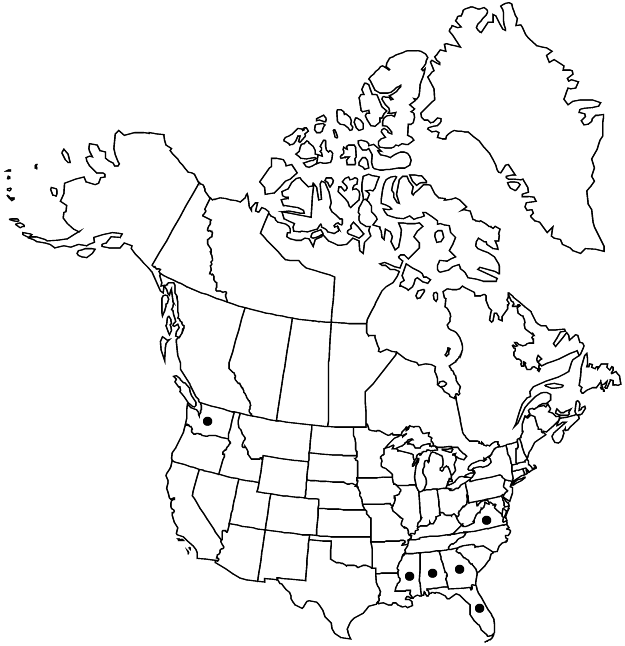Sarracenia leucophylla
Fl. Ludov., 14. 1817 ,.
Plants forming dense clumps; rhizomes 1–2.5 cm diam. Pitchers marcescent, appearing just after or with flowers, spring flush of pitchers followed by delayed flush of similar-shaped, more robust pitchers in late summer, erect, green proximally, distal portion of tube with white areolae all around and with conspicuous green to pink to red venation, 25–100 cm, thick, firm, surfaces glabrous or very finely pubescent, wings 0.5–1.5(–2) cm wide; orifice ovate, 2–6(–8) cm diam., rim white to green or reddish, flaring and loosely revolute, often with prominent, everted indentation immediately distal to wing forming spout over wing; hood recurved adaxially, held well beyond and covering orifice, dominated by white areolae bordered by tissues and veins that are white, green, or red, orbiculate-reniform to ovate-reniform, undulate, 2.5–6.5 × 2–6(–8) cm, longer than wide, base cordate, not narrowed to neck, 0.5–1.5 cm, (proximal margins abaxially revolute), apiculum (1–)2–3 mm, adaxial surface densely strigose with hairs to 1.5 mm. Phyllodia 5–6(–8), erect, oblanciform, 15–50 × 2–3 cm. Scapes 30–80 cm, shorter than pitchers; bracts 0.5–1 cm. Flowers slightly fragrant; sepals maroon, 3.5–5 × 1.8–3 cm; petals maroon to red, distal portion orbiculate to rhombic, 4–5 × 1.5–3.5 cm, margins entire; style disc blush red, 6–7 cm diam. Capsules 1.5–2 cm diam., acropetally dehiscent. Seeds 1.5–2.1 mm. 2n = 26.
Phenology: Flowering Mar–Apr.
Habitat: Bogs, wet pine savannas and flatwoods, boggy borders of branch bays and cypress depressions, ecotones of baygalls, fresh-tidal shrub-herb thickets
Elevation: 0-90 m
Distribution

Ala., Fla., Ga., Miss., Va., Wash.
Discussion
Sarracenia leucophylla occurs on the coastal plain of the Florida panhandle west of the Ochlockonee River, and across southern Alabama to southeastern Mississippi; it is rare in southwestern Georgia, introduced and established in southeastern Virginia, and a rare escape in Skagit County, Washington.
Sarracenia leucophylla is a striking plant, noticeable from a distance, and capable of forming extensive, nearly solid stands in open, wet meadows and seepage slopes and pine flatwoods across the Gulf Coast region. The number of populations has been severely reduced by development and fire suppression. Its spring pitchers are not as robust or profuse as the late–summer pitchers, the latter especially attracting moths. This species responds well to winter fires, resulting in abundant growth later that spring. In some managed areas, the attractive tubes are judiciously harvested and sold, fresh or dried, as “cut flowers” in florist shops. Pure white pitchers (no colored veins) with red petals or totally anthocyanin-free individuals with yellow petals occur.
Capsules of Sarracenia leucophylla dehisce acropetally rather than basipetally as in all other species in the family. G. W. Folkerts and D. R. Folkerts (1989) hypothesized that this adaptation allows seeds to be released with less likelihood of being caught and held by the persistent style discs.
Selected References
None.